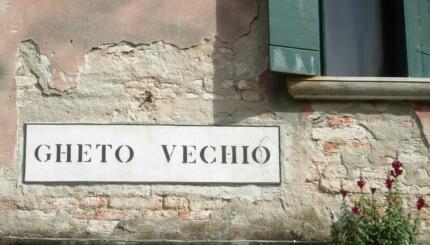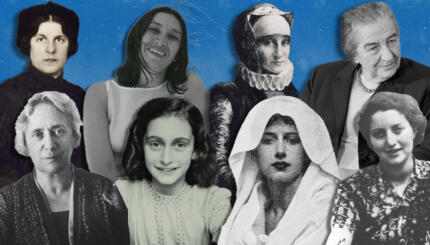Within five years of the start of the Gold Rush in 1848, more than 5,000 Jews migrated to California in search of opportunity, joining members of other religious and ethnic groups. After 1858, with most of the California mining sites appropriated, gold seekers migrated to new strikes in Colorado, Nevada, Montana, Idaho, and Oregon.
Civilizing the West
Jews also fanned out across other nearby states, including Arizona, New Mexico, Utah, Wyoming, and Washington, and by 1920 numbered about 300, 000 in the West. Jewish women were central to the region’s economic, political, social and cultural development.
Some of these women were the wives, daughters, and sisters of the Jewish merchant elite, with the means and leisure time available for prominent involvement in civil life and social welfare issues. Many more, however, performed daily work within their households, contributing to family income as well as taking part in the foundation of philanthropic institutions, synagogues, schools, and libraries. Together, these women helped civilize the raw West and construct communities where social order and Jewish family life could flourish.
Particularly in early western boom towns–where growth was often rapid and chaotic and the number of females small–mutual assistance was critical, and western women often enjoyed more equal status than women in other regions. Domestic skills, for example, commanded top dollar. Many women became seamstresses and food purveyors, or pursued hotel and boarding house ventures.

Help us keep Jewish knowledge accessible to millions of people around the world.
Your donation to My Jewish Learning fuels endless journeys of Jewish discovery. With your help, My Jewish Learning can continue to provide nonstop opportunities for learning, connection and growth.
This path was successfully followed by western Jewish women like Mary Ann Cohen Magnin in California, a talented fine embroiderer who became the guiding hand behind the famous upscale women’s clothing store, I. Magnin and Company; Anna Freudenthal Solomon in Arizona, who first ran a general store and later a successful hotel for nearly twenty-five years, while raising a large family; Jeanette Hirsch Meier of Portland, Oregon, who after her husband’s death presided over the largest department store in the far West; and Regina Moch of Eureka, Nevada, who operated a thriving restaurant that supported her after the death of her husband in a local fire.
A Golden Era
As time passed, the innovative environment of the West offered western Jewish women the possibility of greater access to higher education, professional positions, and entry into formal politics. Fledgling Jewish female journalist Alice G. Friedlander of Oregon proclaimed in a speech before the Portland Press Club in 1893: "This is women’s golden era…The time is near when women will hold office, and the law, medicine, education–every walk of life requiring intellectual rather than manual force is wide open to the women of America." While some women may have found Alice’s words overly optimistic, her sentiments do convey the sense of promise that was felt by many western women at the time.
Jewish women benefited from the region’s generally liberal attitude toward education for females. In 1900, the percentage of young women enrolled in high school was the highest in the West, and the University of California became a co-ed institution as early as the 1870s. In 1900, 15.2% of western women were professionals, while only 8.1 % of women nationally held professional occupations, undoubtedly reflecting wider opportunities for women in the American West.
It is noteworthy that women’s suffrage came earliest to the American West. By 1900, women could vote in Wyoming, Colorado, Utah, and Idaho, and by the time the Nineteenth Amendment to the constitution was passed in 1920, women in every western state with the exception of New Mexico had already been enfranchised. Jewish political activist Belle Fligelman Winestine recalled a humorous but telling incident that reflects the pioneering spirit of some of the Jewish women who were interested in politics.
According to Belle, Ghetty Fligelman made her displeasure over her stepdaughter’s high-profile political involvement very clear. "While it was all right for women to vote she said, no respectable lady would speak on a street corner. She warned me that if I made one more speech on the street, I needn’t come home. That night I slept at a hotel and charged it to my father." ("Mother Was Shocked," Montana 24 (1974), p. 73)
In the second half of the nineteenth and the early twentieth century, Jewish women across America were highly visible in social welfare and progressive reform endeavors, commerce, higher education and the professions, and Jewish life. However, considering the modest number of Jewish women in the early American West, the level of involvement of Jewish female pioneers is particularly striking.
The region produced many notable figures, including: Frances Wisebart Jacobs, Denver’s "Mother of Charities" and the impetus behind the founding of National Jewish Hospital for Consumptives (NJH) in 1899 as well as the Charity Organization Society, forerunner of the national United Way; educator Mary Goldsmith Prag, the first Jewish women to serve on San Francisco’s Board of Education and her daughter Florence Prag Kahn, elected the first Jewish congresswoman in America in 1924; Seraphine Eppstein Pisko of Denver, who became the executive director of NJH in 1911, probably the first Jewish woman in the United States to head a national organization; pioneer social worker Ida Loewenberg of Oregon; Felice Kohn, one of Nevada’s earliest female lawyers, who authored Nevada’s women suffrage legislation; writer Selina Solomons, the activist president of San Francisco’s Votes-for Women-Club and journalist Belle Fligelman Winestine, who were instrumental in securing the right of women to vote in California and Montana respectively; and Jessica Peixotto, who received a Ph.D. at the turn of the century and became UCLA’s first female full professor in 1918.
Unprecedented Opportunity
The West offered unprecedented opportunity to Jews, and Jewish women were quick to take advantage of new opportunities. Given their often relatively small numbers within western communities, their influence was significant, and they pushed public boundaries in ways their eastern counterparts often did not. Many Jewish women and men arrived in the West just as settlements were being founded or soon after, easing their social, political and social integration.
Even as they were part of the larger western community, however, on the whole early western Jewish women retained their distinctive religious and ethnic character. In addition to contributing to the West’s overall development, Jewish women also contributed fundamentally to the development and maintenance of Jewish communal life.
The migration of Jewish women to western communities often heralded the organization of Jewish institutions. Most western Jewish communities featured Ladies’ Hebrew Benevolent Societies, dedicated to charitable projects. Many women, such as Therese Marx Ferrin in Arizona and Bertha Frank Meyers in Wyoming, were instrumental in the building of synagogues and the fundraising apparatus to carry on these religious institutions.
Jewish women played a pivotal part in sustaining and transmitting Judaism, both in their roles in the home and by supporting synagogues, religious schools, and Jewish and general philanthropic endeavors. As active community builders in a variety of domestic roles, Jewish women in the West were poised to take advantage of unprecedented opportunities in a new and dynamic region.


